Mongoose
| Mongoose[1] Temporal range: Oligocene to present | |
|---|---|
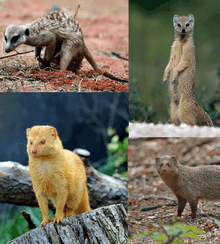 | |
| Top left: Suricata suricatta Top right: Cynictis penicillata | |
| Scientific classification | |
| Kingdom: | Animalia |
| Phylum: | Chordata |
| Class: | Mammalia |
| Order: | Carnivora |
| Suborder: | Feliformia |
| Family: | Herpestidae Bonaparte, 1845 |
| Type genus | |
| Herpestes Illiger, 1811 | |
| Genera | |
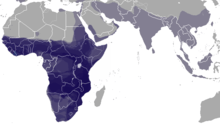 | |
| Synonyms | |
| |
Mongoose is the popular English name for 29 of 34[2] species in the 14 genera of the family Herpestidae, which are small carnivorans that are native to southern Eurasia and mainland Africa. The other five species in the family are the four kusimanses in the genus Crossarchus, and the only species in the genus Suricata: Suricata suricatta, commonly called meerkat in English.
Six species in the family Eupleridae, endemic to the island of Madagascar, are also called "mongoose" and were originally classified as a genus within the family Herpestidae, but genetic evidence has since shown that they are more closely related to other Madagascar carnivorans in the family Eupleridae; they have, since 2006, been classified in the subfamily Galidiinae within Eupleridae.
Herpestidae is placed within the suborder Feliformia, together with the cat, hyena, and civet families.
Name
.jpg)
The word "mongoose" is derived from the Marathi name mungūs (मुंगूस) (pronounced as [muŋɡuːs]). The form of the English name (since 1698) was altered to its "-goose" ending by folk-etymology.[3] It has no etymological connection with the word goose. Historically, it has also been spelled "mungoose".[4] The plural form is mongooses,[5] or, rarely, mongeese.[6]
Description
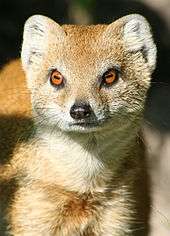
Mongooses live in southern Asia, Africa, and southern Europe, as well in Fiji, Puerto Rico, and some Caribbean and Hawaiian islands, where they are an introduced species.
The 34 species range from 24 to 58 cm (9.4 to 22.8 in) in length, excluding the tail.[7] Mongooses range in weight from the common dwarf mongoose, at 320 g (11 oz), to the cat-sized white-tailed mongoose, at 5 kg (11 lb).[7]
Some species lead predominantly solitary lives, seeking out food only for themselves, while others travel in groups, sharing food among group members and offspring.
Anatomy
Mongooses bear a striking resemblance to mustelids, having long faces and bodies, small, rounded ears, short legs, and long, tapering tails. Most are brindled or grizzly; a few have strongly marked coats. Their nonretractile claws are used primarily for digging. Mongooses, much like goats, have narrow, ovular pupils. Most species have a large anal scent gland, used for territorial marking and signaling reproductive status. The dental formula of mongooses is similar to that of viverrids: 3.1.3-4.1-23.1.3-4.1-2.
Mongooses also have receptors for acetylcholine that, like the receptors in snakes, are shaped so that it is impossible for snake neurotoxin venom to attach to them. Mongooses are one of four known mammalian species with mutations in the nicotinic acetylcholine receptor that protect against snake venom.[8] Pigs, honey badgers, hedgehogs, and mongooses all have modifications to the receptor pocket that prevents the snake venom α-neurotoxin from binding. These represent four separate, independent mutations. In the mongoose, this change is effected uniquely, by glycosylation.[9] Researchers are investigating whether similar mechanisms protect the mongoose from hemotoxic snake venoms.[8]

Life history
In contrast to the arboreal, nocturnal viverrids, mongooses are more commonly terrestrial and many are active during the day.
The Egyptian mongoose (Herpestes ichneumon) is sometimes held as an example of a solitary mongoose, though it has been observed to work in groups.[10]
Diet
Mongooses mostly feed on insects, crabs, earthworms, lizards, birds, and rodents. However, they also eat eggs and carrion.

The Indian gray mongoose and others are well known for their ability to fight and kill venomous snakes, particularly cobras. They are adept at such tasks due to their agility, thick coats, and specialized acetylcholine receptors that render them resistant or immune to snake venom.[11] However, they typically avoid the cobra and have no particular affinity for consuming its meat.[12] Although mongooses readily attack snakes, they have extreme difficulty in combatting vipers and constrictors, as cobras and other elapids lose fighting energy through their intense bluff, and will end up easy to overpower. Constrictors and vipers, however, attack faster and more powerfully, so the mongoose would end up losing.

Some species can learn simple tricks. They can be semi-domesticated and are kept as pets to control vermin.[13] However, they can be more destructive than desired; when imported into the West Indies to kill rats, they destroyed most of the small, ground-based fauna. For this reason, it is illegal to import most species of mongooses into the United States,[14] Australia, and other countries. Mongooses were introduced to Hawaii in 1883 and have had a significant negative effect on native species.[15]
Reproduction
The mongoose emits a high-pitched noise, commonly known as giggling, when it mates. Giggling is also heard during courtship.[16] Communities of female banded mongooses (Mungos mungo) synchronize their childbearing to the same day to deter infanticide by dominant females.[17]
Relationship with humans



Mongooses are a common spectacle at roadside shows in Pakistan. Snake charmers keep mongooses for mock fights with snakes. On Okinawa (where mongooses were misguidedly brought in to control the local habu snake), mongoose fights with these highly venomous snakes (Ovophis okinavensis and Trimeresurus flavoviridis) in a closed perimeter were presented as spectator events at such parks as Okinawa World; however, due to pressure from animal rights activists, the spectacle is less common today.[18]
According to Greek historian Diodorus Siculus (1.35 & 1.87), Egyptians venerated native mongooses (Herpestes ichneumon) for their ability to handle venomous snakes and for their occasional diet of crocodile eggs. The Buddhist god of wealth Vaiśravaṇa, or Dzambala for Tibetans, is frequently depicted holding a mongoose that is spitting jewels from its mouth.[19] The Hindu god of wealth, Kubera (being the son of Vishrava ("Fame"), Kubera is also called Vaisravana), is often portrayed holding a mongoose in his left hand, hence the sight of a mongoose is considered lucky by some.[20]
All mongoose species, except for Suricata suricatta, are classed as a "prohibited new organism" under New Zealand's Hazardous Substances and New Organisms Act 1996, preventing them from being imported into the country.[21]
In popular culture
A well-known fictional mongoose is Rikki-Tikki-Tavi, which appears in a short story of the same title in The Jungle Book (1894) by Rudyard Kipling. In this tale set in India, the young mongoose saves his family from a krait and from Nag and Nagaina, two cobras. The story was later made into several films, and also a song by Donovan, among other references. A mongoose also features in Bram Stoker's novel, The Lair of the White Worm. The main character, Adam Salton, purchases one to independently hunt snakes. Game Freak's Pokémon franchise has a Pokémon named Zangoose that is based on and named after the mongoose.
As noted earlier, the mongoose is a prohibited animal in the United States (with the exception of Hawaii). However, an exception was made in the 1963 case of "Mr. Magoo", a mongoose brought to the Minnesota port of Duluth by a merchant seaman. Mr. Magoo, as the animal was to become known, faced being euthanized, but a public campaign resulted in the intervention of Secretary of the Interior Stewart Udall, who exempted Magoo from the regulations. Magoo lived out his days on display as the most popular attraction of the Duluth Zoo, dying of old age in 1968.[22]
Colombian artist Shakira named her first worldwide concert tour Tour of the Mongoose.
Taxonomy
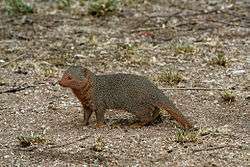
Like other feliformian carnivorans, mongooses descended from the viverravines, which were civet- or genet-like mammals. Older classifications sometimes placed mongooses in the family Viverridae, but both morphological and molecular evidence speaks against the monophyly of this group, though they do have the same basic dental formula as the viverrids. Mongooses also have characteristic behavioral features that distinguish them from viverrids and other feliformian families. Less diverse than the viverrids, the mongoose family includes 14 genera and 34 species.
Mongooses are related to the other feliformian families, including Hyaenidae (hyenas), Viverridae (civets), and Felidae (cats). They are more distantly related to the caniformian carnivorans, including the family Mustelidae, which contains weasels, badgers, and otters.
Genetic evidence indicates the family Eupleridae is the closest living group to mongooses. The Eupleridae contain the fossa and the other smaller Malagasy carnivorans.
Genetic evidence from several nuclear and mitochondrial genes argues against placing Malagasy galidiines in the mongoose family; instead, these species are more closely related to other Madagascar carnivorans, including the fossa and Malagasy civet.[23][24] As a result, this subfamily was moved from Herpestidae to Eupleridae.
Classification
- Family Herpestidae
- Genus Atilax
- Marsh mongoose, Atilax paludinosus
- Genus Bdeogale
- Bushy-tailed mongoose, Bdeogale crassicauda
- Jackson's mongoose, Bdeogale jacksoni
- Black-footed mongoose, Bdeogale nigripes
- Genus Crossarchus
- Alexander's kusimanse, Crossarchus alexandri
- Angolan kusimanse, Crossarchus ansorgei
- Common kusimanse, Crossarchus obscurus
- Flat-headed kusimanse, Crossarchus platycephalus
- Genus Cynictis
- Yellow mongoose, Cynictis penicillata
- Genus Dologale
- Pousargues's mongoose, Dologale dybowskii
- Genus Galerella
- Angolan slender mongoose, Galerella flavescens
- Somali slender mongoose, Galerella ochracea
- Cape gray mongoose, Galerella pulverulenta
- Slender mongoose, Galerella sanguinea
- Black mongoose, Galerella nigrata (recently added)
- Genus Helogale
- Ethiopian dwarf mongoose, Helogale hirtula
- Common dwarf mongoose, Helogale parvula
- Genus Herpestes
- Short-tailed mongoose, Herpestes brachyurus
- Indian gray mongoose, Herpestes edwardsii
- Indian brown mongoose, Herpestes fuscus
- Egyptian mongoose, Herpestes ichneumon
- Small Asian mongoose, Herpestes javanicus
- Long-nosed mongoose, Herpestes naso
- Collared mongoose, Herpestes semitorquatus
- Ruddy mongoose, Herpestes smithii
- Crab-eating mongoose, Herpestes urva
- Stripe-necked mongoose, Herpestes vitticollis
- Genus Ichneumia
- White-tailed mongoose, Ichneumia albicauda
- Genus Liberiictus
- Liberian mongoose, Liberiictis kuhni
- Genus Mungos
- Gambian mongoose, Mungos gambianus
- Banded mongoose, Mungos mungo
- Genus Paracynictis
- Selous' mongoose, Paracynictis selousi
- Genus Rhynchogale
- Meller's mongoose, Rhynchogale melleri
- Genus Suricata
- Meerkat, Suricata suricatta
- Genus Atilax
The Sokoke bushy-tailed mongoose, Bdeogale omnivora,[25] has not been included in the above list as many authorities consider it to be a subspecies of the bushy-tailed mongoose, Bdeogale crassicauda.[1]
Gallery
For pictures of mongooses on Madagascar, see Galidiinae
-

Mongoose, or Mangouste as depicted in the 1851 Illustrated London Reading Book
-

Common kusimanse, Crossarchus obscurus
-

Angolan slender mongoose (Galerella flavescens)
-

Slender mongoose, Galerella sanguinea
-

Banded mongoose, Mungos mungo
-
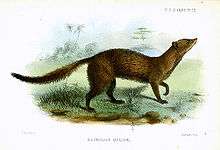
Meller's mongoose, Rhynchogale melleri
-

Meerkat, Suricata suricatta
-

Banded mongoose
-

Stripe-necked mongoose, Herpestes vitticollis
-
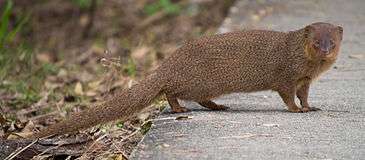
Small Asian mongoose, Herpestes javanicus
-
-_is_it-_at_Hyderabad%2C_AP_W_106.jpg)
Indian gray mongoose, Herpestes edwardsii
-

Indian gray mongoose pups
-
_(2).jpg)
Yellow mongoose, Cynictis penicillata
-

Cynictis penicillata mating
-

Yellow mongoose
-
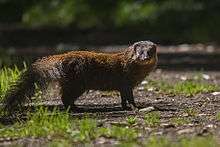
Indian brown mongoose, Herpestes fuscus
References
- 1 2 Wozencraft, W.C. (2005). "Order Carnivora". In Wilson, D.E.; Reeder, D.M. Mammal Species of the World: A Taxonomic and Geographic Reference (3rd ed.). Johns Hopkins University Press. pp. 562–571. ISBN 978-0-8018-8221-0. OCLC 62265494.
- ↑ Vaughan, Terry A.; James M. Ryan; Nicholas J. Czaplewski (2010). Mammalogy. Jones & Bartlett Learning. p. 300. ISBN 0-7637-6299-7
- ↑ Forsyth, Mark (2012). The Etymologicon: A Circular Stroll Through the Hidden Connections of the English Language. Penguin. ISBN 1101611766. Retrieved June 16, 2013.
- ↑ Lydekker, R. 1894. A hand-book to the Carnivora. Part 1, Cats, civets, and mungooses. London: Allen.
- ↑ "Dictionary.com: mongoose". Retrieved 2008-08-22.
- ↑ "Merriam-Webster: mongoose". Retrieved 2006-04-12.
- 1 2 Macdonald, D., ed. (2009). The Encyclopedia of Mammals. Oxford: Oxford University Press. p. 660. ISBN 978-0-19-956799-7.
- 1 2 Hedges, Stephen. "Science: Mongoose's secret is to copy its prey"; New Scientist; 11 January 1997. Retrieved 16 November 2007.
- ↑ Drabeck, D.H.; Dean, A.M.; Jansa, S.A. (June 1, 2015). "Why the honey badger don't care: Convergent evolution of venom-targeted nicotinic acetylcholine receptors in mammals that survive venomous snake bites.". Toxicon (Elsevier) 99: 68. doi:10.1016/j.toxicon.2015.03.007.
- ↑ "Animal Diversity Web: Herpestes ichneumon". Retrieved 2006-04-12.
- ↑ "How the Mongoose Defeats the Snake". Retrieved 2010-10-25.
- ↑ Mondadori, Arnoldo, ed. (1988). Great Book of the Animal Kingdom. New York: Arch Cape Press. p. 301.
- ↑ Sherman, D. M. (2002). Sherman, D. M. (2002). Tending Animals in the Global Village: A Guide to International Veterinary Medicine. Philadelphia: Lippincott Williams & Wilkins. p. 45. ISBN 0683180517.
- ↑ "Animals whose importation is banned under the Lacey Act". Retrieved 2006-04-12.
- ↑ "Star Bulletin: Traps set to catch mongoose on Kauai". Retrieved 2006-04-12.
- ↑ Poushali Ganguly. "Mongoose Facts". Buzzle.
- ↑ Marshall, Tom. "Mongoose teamwork hides darker side". Retrieved 24 February 2014.
- ↑ Charles, Bill. "Okinawa World Presents Midsummer Thrills." Japan Update. 24 August 2012. http://www.japanupdate.com/archive/index.php?id=12558.
- ↑ "Symbolism of Mongoose in Art". indology list indology.info.
- ↑ "Kuber Golden Temple". kubergoldentemple.org.
- ↑ "Hazardous Substances and New Organisms Act 2003 - Schedule 2 Prohibited new organisms". New Zealand Government. Retrieved 26 January 2012.
- ↑ Remembering Duluth's famous mongoose, Mr. Magoo, by Andrew Krueger at the Duluth News Tribune (via archive.org); published November 30, 2010; retrieved July 27, 2014
- ↑ Yoder, A. D.; Zehr, Sarah; Delefosse, Thomas; Veron, Geraldine; Goodman, Steven M.; Flynn, John J.; et al. (2003). "Single origin of Malagasy Carnivora from an African ancestor". Nature 421 (6924): 434–437. doi:10.1038/nature01303. PMID 12610623.
|first2=missing|last2=in Authors list (help) - ↑ Flynn, J. J.; 2, JA; Zehr, S; 3, J; Nedbal, MA (2005). "Molecular Phylogeny of the Carnivora (Mammalia): Assessing the Impact of Increased Sampling on Resolving Enigmatic Relationships". Systematic Biology 54 (2): 317–337. doi:10.1080/10635150590923326. PMID 16012099.
- ↑ IUCN Red List of Threatened Species: Bdeogale omnivora
Further reading
- Rasa, Anne (1986). Mongoose Watch: A Family Observed. Garden City, NY: Anchor Press/Doubleday & Co. ISBN 9780385231756. OCLC 12664019. Translation of Die perfekte Familie.
- Hinton, H. E. & Dunn, A. M. S. (1967). Mongooses: Their Natural History and Behaviour. Berkeley: University of California Press. OCLC 1975837.
External links
| Wikispecies has information related to: Herpestidae |
-
 Media related to Herpestidae at Wikimedia Commons
Media related to Herpestidae at Wikimedia Commons -
 "Ichneumon". Encyclopædia Britannica (11th ed.). 1911.
"Ichneumon". Encyclopædia Britannica (11th ed.). 1911.